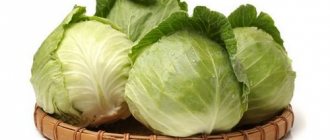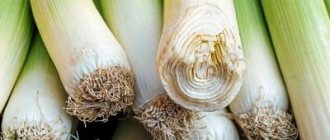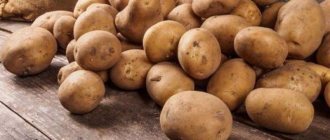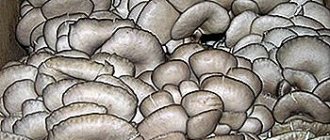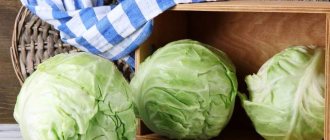There is an opinion that white cabbage firmly holds second place in popularity, giving way to potatoes. But how can I say it? In other families, cabbage is the leader. Here, cabbage soup and borscht, dumplings and cabbage rolls, kulebyaki, casseroles and many other dishes are held in high esteem. But how to ensure that fresh vegetables can be eaten before the new harvest? How to store cabbage in an apartment?
The answer is not so simple if there is no cellar, garage, dacha or even an ordinary storage room, which were endowed with multi-storey buildings of the era of N.S. Khrushchev. Most city dwellers have only a balcony and a refrigerator. True, recently freezers have appeared in many apartments, in which many vegetables and fruits can be frozen for a long time. But this is a topic for a separate article. Now let's figure out how to keep cabbage fresh in your apartment.
Selection and preparation of heads of cabbage
Before you start storing cabbage at home, you need to prepare it. Medium-sized forks are best stored, tight, round, slightly flattened. If they went on sale in late autumn, therefore, they belong to late-ripening varieties intended for long-term storage. But there is a catch here too. Loose specimens (even from late hybrids) are not suitable for storage. Early and mid-ripening varieties are also not suitable. Their savings period is limited to a maximum of three months.
But not only the variety plays a role in the shelf life of fresh vegetables. Before harvesting, each fork must be carefully inspected. If cracks or damage from pests are found, they should be put aside and consumed as soon as possible. Be sure to cut off the remaining stems. The stronger the better. After all, during long-term storage, cabbage begins to grow - it forms small heads of cabbage or puts out flower stalks.
The cover leaves are also removed, leaving no more than a couple of leaves on the head of cabbage. It must be remembered that these green leaves protect the forks from damage. Therefore, there is no need to peel the cabbage until it is white. You should get smooth and beautiful heads of cabbage with several covering leaves.
Also, be sure to wash the forks in running cool water. Water should be supplied under pressure to wash away stuck insects and remaining soil or sand. A shower is best suited for this purpose. Then the heads of cabbage are wiped with a cloth, or a waffle towel, so that no moisture remains. This is the basis of how to preserve cabbage for the winter.
Canned storage
Homemade preparations are a great way to store cabbage. Canned cabbage can last for a long time, maintaining its beneficial qualities.
Pickling
For pickling, it is recommended to take juicy, white, healthy forks.
The safest way to prepare shredded cabbage is pickling. In this case, fermentation occurs naturally, and vinegar is not added to the dish. For pickling, it is recommended to take juicy, white, healthy forks.
Sauerkraut recipe
Ingredients:
- cabbage –4 kg;
- carrots – 400 g;
- salt – 80 g;
- sugar – 80 g.
Preparation:
- Use a knife or a coarse grater to chop the cabbage and carrots.
- Three-liter jars are sterilized for 10 minutes.
- Shredded vegetables are sprinkled with sugar and salt and crushed.
- Fill the prepared container, compacting it with your hands. Excess juice can be drained.
Cover with a lid and leave for five days to ferment. Then the container with sauerkraut is put in a cold place.
Pickling
Pickled cabbage is prepared from fresh vegetables doused with a special marinade. The jars used for this must be sterilized. There are many ways to pickle cabbage.
Pickled cabbage
Pickled cabbage recipe
Ingredients:
- boiling water – 1 l;
- vinegar – 1 tsp;
- sugar – 2 tbsp. l.;
- salt – 1.5 tbsp. l.;
- carrots – 400 g;
- fresh cabbage – 1.5 kg.
Preparation:
- Use a coarse grater to grate the carrots and finely chop the cabbage.
- Mix everything together and place it in a sterilized (10 min) three-liter jar.
- Sprinkle salt, sugar and vinegar essence on top.
- Pour boiling water over it, cover it with an iron lid and roll it up.
Canning
Canned cabbage is a common winter preparation. Even substandard fruits can be used for canning, after first removing them from the affected areas.
Canned cabbage
Canned Cabbage Recipe
Ingredients:
- fresh cabbage – 1 kg;
- carrots - 6 medium-sized pieces;
- garlic – 7 cloves;
- water – 0.1 l.;
- vinegar (9%) – 10 tbsp. l.;
- salt – 1 tbsp. l.;
- sugar – 100 g;
- sunflower oil – 0.1 l.
Preparation:
- Shred the cabbage into thin strips, grate the carrots and garlic. Everything is mixed together.
- Sunflower oil, salt and sugar are added to the water. Put everything on the fire and bring to a boil. Add vinegar.
- The resulting brine is added to the chopped vegetables and left to infuse for 2 hours.
- The cabbage is placed in prepared sterilized jars and sealed with iron lids.
Refrigerator comes first
For residents of modern urban neighborhoods, refrigerators are the most convenient and accessible place for long-term storage of cabbage. By placing forks in the vegetable compartment, you can be sure that they will not spoil within 3 months. True, over time the vegetable will become lethargic and lose its attractiveness. But if you periodically remove the wilted leaves, you can increase the shelf life.
True, the forks will decrease in size each time. However, if there is no way out, you can store the cabbage in the refrigerator for the winter. With this storage, the heads of cabbage will not lose all their beneficial properties. The set of minerals, vitamins, and nutrients will be preserved.
But you can increase the shelf life if you wrap each fork in protective cling film. Believe me, the entire arsenal of useful substances, beautiful appearance - absolutely everything will last at least 2 times longer. The most important thing is that the vegetable will not cease to be crispy, as if it had just been picked from the garden. This is easy to achieve if you do proper preparation before storing cabbage at home.
By the way, Chinese and Chinese cabbage are only stored in the refrigerator. Karsnokochanka and Savoy also “live” quite well in it. The situation is different with cauliflower, kohlrabi, Brussels sprouts and Romanesco. It is not recommended to keep these types of cabbage in the refrigerator for a long time; they will become stale.
How to properly harvest cabbage for later storage
The harvest will be saved if certain conditions are met. Much depends on the correctness of the collection process. It is best carried out from late August to October. Gardeners are advised to use the following useful tips:
- The harvest is harvested in sunny weather. The root is dug up and cleared of soil.
- It is best to throw away defective heads immediately. Until next year, only fresh and beautiful vegetables will remain. That is why it is advisable to sort out the crop. Small heads are recommended to be used immediately.
- To dry, the heads of cabbage are laid out on a wooden platform under a canopy and left for a day.
- Whether it is necessary to cut off the roots is decided depending on the chosen storage method.
Useful articles for gardeners and gardeners
Lunar calendar for September 2021 for gardener and vegetable gardener
Planting days in September 2021 in the Moscow region
Moon phases in September 2021 by day for gardeners and gardeners
DIY autumn pruning of fruit trees and shrubs
- Then the cabbage is laid out on shelves or placed in special boxes.
Balcony as storage for vegetables
The main disadvantage of storing vegetables in the refrigerator is that there is not enough space. Even the most spacious can accommodate no more than ten heads of cabbage. In addition, there are other products that are placed in vegetable chambers. A loggia or balcony can be a salvation if they are glazed and sufficiently insulated.
Storing cabbage on the balcony is a great option. You couldn't find a better place in the apartment. Typically, a lockable cabinet with shelving is installed for these purposes. The heads of cabbage are wrapped in paper or cling film and placed in one row so that there is a small space between the forks. Newspapers should not be used as they contain ink containing harmful substances. Another rule is that you cannot store cabbage on the balcony in winter if the air temperature on the balcony drops to sub-zero values.
You need to check vegetables monthly and remove forks that show signs of rotting. In the spring, such a check should be carried out weekly, or more often. Beijing, as well as Romanesco and broccoli cannot be stored on the balcony. This cabbage here will quickly become unusable due to temperature changes.
Possible problems and ways to solve them
When storing crops, problems may arise that need to be addressed immediately:
The cabbage began to quickly rot from the inside .
Damaged heads of cabbage cannot be saved; they must be disposed of. Most often, the reason for rapid spoilage is contamination of vegetables on the site. This is why minimal contact between the plugs and each other is so important.- The upper leaves deteriorate . The reason lies in the air temperature being too high. To save the crop, it needs to be moved to a cooler place.
- The forks are fading . This occurs due to loss of moisture. You need to try to preserve it in any available way: wrap the vegetables in film, coat them with clay, wrap them in paper.
Or maybe it’s still a storage room?
If the apartment has a small pantry, you can equip it with cabbage storage. Only the pantry should not be in the kitchen. It is better if it is in the corridor, closer to the front door. The ideal location for a storage room would be a stairwell.
To store the pantry, forks with a well-cut stalk are carefully covered with cling film, and always in several layers. When wrapping, you need to press the film into the head of cabbage to remove excess air. When inspecting the heads of cabbage, which must be done at least once every 10 days, remove the rotten leaves and re-wrap the leaves with film. This is the simplest method for storing cabbage in an apartment. But in modern residential high-rises such storage rooms are not provided.
Preparation for storage
In order to preserve the beneficial properties and increase the shelf life of cabbage, you need to take a number of precautions.
Step 1. Remove the heads of cabbage in a timely manner
The daytime temperature to start harvesting cabbage should be within 2–8 degrees; at night there may be light frosts, but not lower than -3 °C. If we remove the heads of cabbage earlier, they will quickly begin to deteriorate and crack.
Step 2. Properly cut cabbage for storage
Prepare a sharp, durable knife for cleaning. The heads of cabbage need to be cut off, leaving stalks 2-3 cm long. If we hang the cabbage for storage, then we don’t need to cut the stalks, you can even leave the roots, they will slow down drying.
Step 3. Clean from dirt, remove top leaves
Clean the heads of cabbage well from the soil. Leave 2–3 leaves to protect against mechanical damage and diseases, remove the remaining upper leaves.
Step 4. Sort carefully
Select dense, even, firm, whole heads of cabbage. Discard underdeveloped heads of cabbage. Check the heads of cabbage for mechanical damage and cracks. Forks affected by pests are also no good; we will send them for processing, pickle them or marinate them.
How long can cabbage be stored in an apartment?
A piece of white cabbage that is not prepared for long-term storage, that is, not wrapped in a paper bag or wrapped in cling film, can be stored at room temperature for no more than seven days. Storing cabbage on the balcony, subject to all the above recommendations, will give you the opportunity to eat fresh produce until June.
Remember
Cabbage in film can be preserved for five months. When frozen, it stays fresh for about 10 months. The shelf life of dried vegetables is one year. In a dry, ventilated pantry, cabbage wrapped in cling film can be stored for several months.
The main thing is to preserve cabbage in an apartment for the winter, you need to understand that this is possible at a constant temperature from minus 1 degree to plus 5 degrees Celsius. Humidity at low temperatures can reach 95 percent, at high temperatures - 80 percent. Of course, it is almost impossible to achieve such values (the refrigerator does not count), and therefore it is better not to store white cabbage for a long time.
Other types of cabbage may not remain in the refrigerator for long. For example, the shelf life of broccoli, cauliflower and peking broccoli is only a couple of weeks. Kohlrabi, however, takes a little longer - 30 days.
What varieties are good for storage?
For long-term storage, it is recommended to take varieties that are resistant to fungal and bacterial diseases. Typically, this characteristic of the plant is written on the package of seeds.
Cabbage is a capricious crop that cannot always be sustained until spring.
Also, healthy heads of cabbage without damage or rot should be selected for storage, as they can cause healthy forks to become sick.
Important! The average shelf life of cabbage is five months.
Preparing the vegetable
Cabbage is removed from the plots after the onset of cold weather and the first frosts. It is the first frosts that help improve the taste of the vegetable, killing the bitterness in it.
Typically, heads of cabbage begin to be cut when the temperature drops below zero degrees. It is advisable to do this in clear weather, when the heads of cabbage are dry and clean. This saves housewives from having to do additional work cleaning vegetables.
Harvesting in rainy weather requires mandatory drying of the heads of cabbage. In this case, you should dry each head of cabbage separately, laying them out on a horizontal plane.
Cabbage is removed from the plots after the onset of cold weather and the first frosts
This allows the forks to rid themselves of excess moisture stagnant in the leaves. Storing vegetables raw contributes to their rapid rotting.
Important! The basis for successful storage of cabbage heads is the dry harvest after the first frost.
Storing heads of cabbage in a suspended state involves harvesting with a “leg”. However, you should not remove all the top leaves, as this will dry out the vegetable faster.
It is not recommended to store forks:
- affected by rot;
- frozen;
- cracked;
- underdeveloped and empty.
Before storing the heads of cabbage, it is recommended to dry the room where the vegetables will be kept for a long time.
Before storing the heads of cabbage, it is recommended to dry the room
Mid-late
The following mid-late cabbage varieties can be planted for the winter:
- "Brigadier-F1";
- "Krautman-F1";
- "Megaton-F1";
- "Present";
- "Kashirka-202";
- "Harvest";
- "Ladozhskaya-22";
- "Winter Gribovskaya".
The growing season of such hybrids is equal to the duration of the calendar summer that prevails in the temperate zone. Therefore, by the onset of the first frost, the heads of cabbage have time to fully ripen.
Late
The harvest of the following late varieties of cabbage can be stored for a long time:
- "Amager-611";
- "Moscow late-15";
- "Wintering-1474";
- "Rusinovka";
- "Snow White".
Late varieties of cabbage are good for making salads, pickling and canning. They are also distinguished by a long ripening period - 6 months.
Useful tips
- When preparing small heads of cabbage for storage, it is recommended to soak each fork in salt water for about a quarter of an hour. Then the head of cabbage is dried with a towel. This rids the product of insects and completely disinfects it.
- Regular inspection of vegetables is necessary. If you find that the leaves begin to lose their color and darken, you need to urgently remove the paper or film from the leaves. After carefully cutting off the rotten leaves, you should wrap the cabbage again.
- If you see that cabbage is losing its appearance, it is better to ferment it or prepare some kind of preserved food.
Now you know how to store cabbage in your apartment. Try these methods and share your own successes. If you have any questions, ask them in the comments.
How to store fresh cabbage for the winter on an ordinary loggia/balcony
Storage methods are the same as those used for cellar storage. You just need to avoid storing it in sand, soil, clay, etc. Technologies that include wrapping heads of cabbage in a paper or film cocoon are quite sufficient. Under such conditions, the shelf life of cabbage is approximately 3.5-4 months. The main thing is that the chosen room in winter should not be too cold or too warm, both of which contribute to the spoilage of vegetables. You can also successfully keep sauerkraut and salted cabbage there.
Well, how can those who are not lucky enough to have any of the mentioned cold rooms preserve cabbage? There is a way out, but alas, only one and not very profitable - a refrigerator. This household unit is available in every family and can partially solve this problem. Of course, even a large refrigerator won’t fit much. Nevertheless, a couple of small heads wrapped in film or a container of sauerkraut can be safely placed and stored for at least 4 months.
In addition, you can store cabbage indoors in frozen or dried form. In recent years, such options have become increasingly popular. Having a special freezer or a spacious freezer in the refrigerator, you can chop and freeze cabbage. It is almost ready for use, which means you will save a lot of time that was previously spent on washing and cutting vegetables.
The disadvantage of this method is that it loses its crispness, deteriorates its appearance, and is used only as part of culinary dishes, since it loses some of its taste when unfrozen.
As for dried cabbage, it is best to use a special device for drying fruits and vegetables. If you don’t have it, an oven preheated to 50 degrees will do.
When dried, the vegetable is stored until next autumn, without losing any of its beneficial properties. This cabbage is used in most culinary dishes.
The downside of this method is that you cannot make a salad from such a product, and it is not suitable for medicinal purposes.
In any case, in order to decide how to store fresh cabbage in the cellar in the winter or in the apartment, whether it is worth salting or fermenting this vegetable for future use, you will have to carefully study the issue, weigh the pros and cons.
Storing vegetables in winter is not at all that difficult, you just need to approach it seriously and take into account everything, from the type of vegetable to the smallest requirements for its storage.
Suitable varieties
White cabbage lasts longer than its exotic relatives - Brussels sprouts, broccoli, Peking, Savoy and cauliflower. However, the keeping quality varies among varieties.
, which in some regions ripen by June, are not suitable for winter stocks Loose heads of thin leaves do not tolerate storage well and quickly begin to rot, so this type of cabbage is served in the days immediately after harvest.
Late varieties and hybrids are considered champions in terms of shelf life. However, many of them are distinguished by tough leaves with hard veins, so they are not consumed fresh, but are used mainly for pickling and pickling.
They will last almost unchanged until next spring.:
- Amager 611 (pictured);
- Aros F1;
- Snow White;
- Geneva F1;
- Wintering 1474;
- Crewmont;
- Turkiz;
- Kharkov winter;
- Miracle F1.
Late cabbage tends to improve taste during storage due to the accumulation of sugars.
To pamper yourself with vitamin salads in winter, you should pay attention to mid-late varieties, especially hybrids :
- Atria;
- Countess F1;
- Dobrovolskaya;
- Winter Gribovskaya;
- Merchant's wife (photo on the right);
- Menza F1;
- Present;
- Symphony F1;
- Filibuster F1.
Selection of heads of cabbage for long-term storage
If you take cabbage at the market or in a store and its variety is unknown, be guided by the following signs :
- Late and mid-late varieties appear on the shelves at the end of September - October. Everything that is sold before is either early cabbage, or imported products, or remnants of last year’s harvest.
- The heads of late-ripening varieties are large and tight, the leaves are strong, tightly adjacent to each other. The upper ones may have a light green tint, but the lower ones are always white.
- The taste of late cabbage is bitter immediately after harvest, but softens after several months of storage.
If possible, choose heads of cabbage with the stalk not cut off at the very base . Such copies are stored longer.
How to store at home
Similar to the methods described above for storing cabbage in the cellar and other places, not only white cabbage, but also all types of cauliflower, as well as kohlrabi, are preserved. Only broccoli is not suitable for these methods, as it quickly loses color and must be frozen. Before planting, be sure to check whether the variety is a late variety suitable for winter storage.
Step by step instructions
If there is no cellar or basement, you can equip your apartment with a place to store cabbage. A loggia or room with good ventilation and the ability to maintain a temperature of no higher than 15°C is suitable for this purpose.
To do this you will need:
- make a pallet from boxes at a height of 10 cm from the floor;
- set boxes with cabbage;
- Ventilate the room regularly.
Before storing when harvesting using any method, always leave 1.5-2 cm of stalks.
What vegetables should you not store next to?
Cabbage is perfectly stored next to other vegetables: potatoes, beets, carrots, celery. However, it is strictly forbidden to store it next to apples. They release plant gas ethylene, which promotes rapid ripening of other fruits. There are no more restrictions for storing cabbage.
The harvest harvested for the winter can be stored in many different ways. Choose one that is convenient for an apartment or private house, arrange the room according to the recommended standards. After landscaping, prepared cabbage of different varieties can remain fresh until spring, maintaining its taste and nutritional qualities.
How to keep a vegetable in a cellar or basement until spring - temperature, lighting, humidity
The best place to store cabbage is a basement or cellar . In order for the conditions to be suitable, it is necessary to create the desired microclimate. So the temperature for storage should be from 0 to + 2 degrees, humidity - from 90 to 98% percent, but for white cabbage it is possible to reduce the temperature by 0.8 degrees below zero.
Before storing vegetables you need to:
- Check the basement or cellar for rodents.
- It is advisable to whitewash the walls and ceiling, for example with a solution of quicklime.
- You can fumigate with sulfur, but this is not entirely safe.
Do not forget to remove all garbage and remnants of old vegetables from storage, otherwise the new crop will quickly deteriorate.

